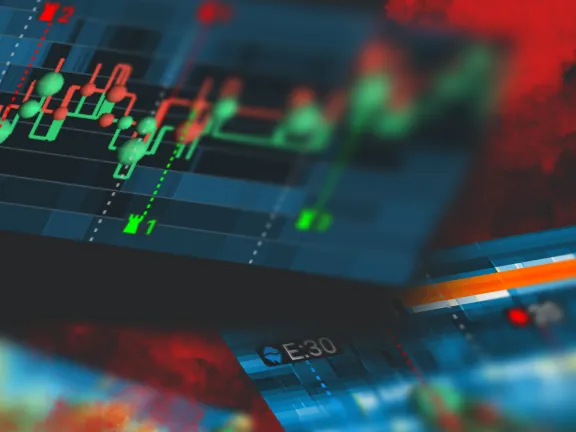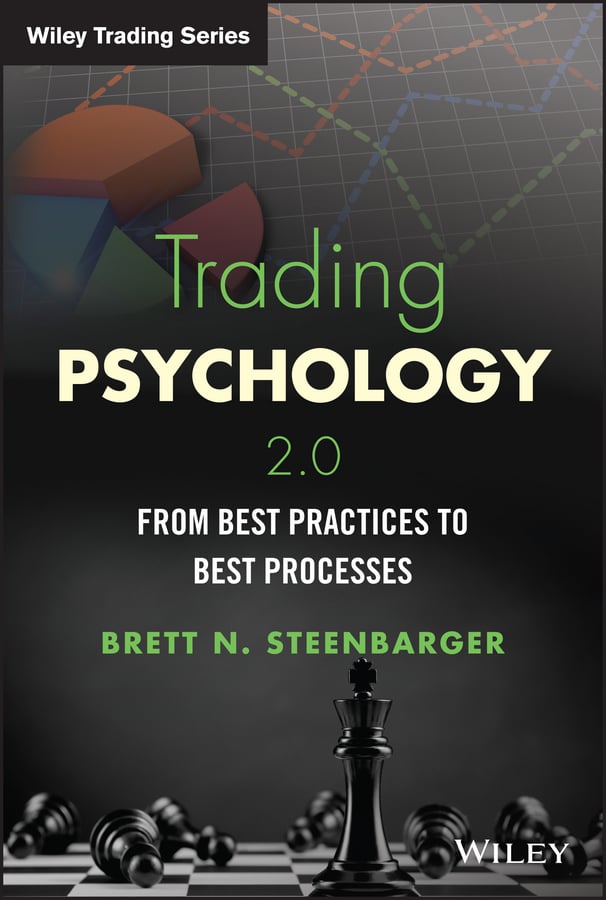

December Trading
Deals Are Live!
Save on Global+, data access,
and add-ons.
See All December Deals

Black Friday
Nov 28-Dec 31
6 days : 22 hours
50% OFF Global+ Quarterly
+ 50% OFF Data (3 months)

Cyber Monday
Dec 1 - Dec 31
6 days : 22 hours
60% OFF Global+ Monthly
+ Data (1 month)

Add-on Deals
Dec 1 - Dec 31
6 days : 22 hours
50% OFF
Add-ons

New Year Sale
Dec 26 - Jan 1
0 days : 22 hours
30% OFF Global+ Lifetime
*Data not included
Book Summaries
March 8, 2024
SHARE
Trading Psychology 2.0 by Brett Steenbarger
Keep up with Bookmap on Social Media

Trading Psychology 2.0: From Best Practices to Best Processes By Brett N. Steenbarger 一 BOOK SUMMARY
About The Author
Brett N. Steenbarger, Ph.D., has been involved in the financial markets since the 1970s and worked as Director of Trader Development at Kingstree Trading in Chicago. A clinical psychologist and active trader, writer, and researcher, he is the author of Enhancing Trader Performance and The Psychology of Trading and other trading psychology books and numerous articles on trading psychology for print and online publications.
About the Book
The immediate catalyst for this book was a review of ten of the top traders and portfolio managers he had worked with throughout the last decade. Trading Psychology 2.0 is grounded in the ABCD themes:
- Adapting to changing markets;
- Building strengths;
- Cultivating creativity;
- Developing best practices and processes.
Watch the Pro Trader Webinar with Brett N. Steenbarger and Scott Pulcini, covering trading psychology mindset and insights.
ADAPTING TO CHANGE
Rarely, do market participants develop explicit processes for adapting to changing markets. Emotional disruptions of trading provide information, often signaling the need to adapt to changing markets. Emotional fixedness fuels functional fixedness. When we identify with a way of trading or a kind of analysis, we not only can’t perceive alternatives: We typically don’t want to see them.
Once we define ourselves as one kind of trader, we sow the seeds of our undoing. If we identify ourselves as trend followers, we leave ourselves vulnerable to frustration in low-volatility, rangy markets. If we identify ourselves as faders of market extremes, we open ourselves to getting run over by strong momentum moves.
In some way, traders are oftentimes looking for self-validation, not profit maximization. And that is a powerful barrier to adaptive change how we think anchors how we trade. We cannot improve our functioning if we experience ourselves as dysfunctional.
Find out how Brett N. Steenbarger introduced the scalper trader Scott Pulcini to Bookmap in our Trading Depth Interview.
The Power of Flexible Commitment
As an active trader, professor Steenberger describes his approach as following:
“Starting with the vast array of technical indicators, I identify a small, low-correlated set of potential market drivers and assess which are influencing price action during the most recent, stable market period. Basic to this approach is the notion of regimes: what drives price during one period is not what moves markets at other times. When I place a trade, I’m not simply betting that the market will rise or fall. I am also making the key assumption that the stable regime that has defined the most recent past will persist into the immediate future.”
There are many ways of understanding and assessing market regimes. To the extent that its cyclical component dominates a market, we want to fade both strength and weakness. Success is not to be found in being either a momentum or a mean-reversion trader; perennial bulls and bears eventually meet with grief. Rather, the key to trading success lies in flexibility — the ability to adapt one’s trading to shifting market environments.
The short life cycles of market regimes ensure that successful traders will be the fastest to adapt to changing market conditions. Whereas, the discipline of sticking to one’s knitting is destined for failure if it is not accompanied by equally rigorous processes that ensure adaptive change. Routine is necessary for efficiency, and adapting routine is necessary for effectiveness. Breaking routine is necessary for adaptation.
CHANGE
Change occurs only once the accumulation of problems necessitates the reach for new solutions. Ironically, no one should be able to do flexible commitment better than traders. The key to the trader’s morning success is not just planning the trade but flexibly planning the trade. It is not enough to be consistent. You must be consistently flexible.
The Perils of (Over)Confidence
You don’t just wake up one morning and discover your trading edge is gone. Behavioral finance research finds consistent confirmation and overconfidence biases among investors and traders. A confirmation bias occurs when we selectively process information that supports our views. Overconfidence biases lead us to overestimate the odds of an anticipated trade or market scenario working out.
Locked into large positions with über-confidence, even flexible traders become inflexible, punctuating winning periods with outsized episodes of drawdown. If your risk-taking mirrors your level of conviction, you will always be most vulnerable — and least able to adapt to changing markets — when you are most overconfident. Our focus on conviction as a success driver may simply reflect the cognitive consequences of survivorship bias. In any group of traders, the ones who lead the pack in absolute returns will almost certainly be high-risk takers.
As traders, we operate in a domain typified by frequent, radical changes: changes in trends, changes in market volatility, changes in correlations, changes in the strategies of market participants, changes in world events, changes in central bank policies, and changes in macroeconomic conditions. Consumed with the day-to-day focus on markets and the need to manage trading risk, we rarely step back and manage change processes effectively.
TURNING ADAPTATION INTO ROUTINE
One of the most common questions I hear from traders is how to not become overemotional during trading, especially when losing money. Not infrequently, traders will lose money and become frustrated or anxious. Frustration leads to impulsive decision-making; anxiety leads to paralysis. The underlying problem is that losses are viewed as threats. However, there is something to be learned from every trade outcome.
Frustration is the mother of adaptation. Comfort — the antipode of urgency — is the enemy of adaptation. Embracing the loss turns trade review into a habit, and that, in turn, makes adaptation a continuous routine. If we are always identifying what we do right during good trades and what we could improve during bad ones, we now have become process-driven in our change efforts. Flexibility has become our routine.
The Limits of Trader Discipline
One of the common teachings of trading coaches states that trading success is a function of superior discipline. Yet, once markets change and traders are now doing the wrong thing, exercising greater discipline in doing the same things only locks in poor returns. Discipline will help us climb the ladder of success more steadily, but in itself doesn’t ensure that the ladder is propped against the right structure.
We commonly hear that traders should develop trading styles that fit their personalities. There is wisdom in this observation. Still, like the received wisdom about trading by conviction and the paramount importance of discipline, the notion of trading one’s personality has its limitations.
Readiness for Change
Typically, the missing ingredient between us and the actions we need to take to make effective changes is urgency. By the time ‘‘want to change’’ becomes ‘‘need to change,’’ it is often too late—because that’s after significant losses have been incurred.
Try a short self-assessment exercise consisting of seven questions to evaluate your level of readiness for change:
- How, specifically, do you expect your market(s) to evolve over the next several years?
- Where, specifically, do you perceive the greatest areas of opportunity in your market(s) over the next several years?
- What, specifically, has been the greatest source of threat to your trading in the past year?
- How would you need to change your trading to keep pace with the shifts in markets, opportunities, and threats noted above?
- What are you doing now, on a regular basis, to master the learning curve needed to exploit the opportunities and avoid the threats you foresee?
- What new markets or market information are you examining in detail to help prepare you for the future?
- If you don’t have clear, specific answers to the above, with whom do you need to speak, and what do you need to research to gain clarity?
Dangers of Trader Isolation
Trading can be a tremendously isolating experience, even on a large trading floor. The potential for trader isolation is a major reason I have emphasized the importance of networking. It is better to move to action through inspiration than desperation.
Networking — meeting up with other traders and ‘‘talking shop’’ — has the potential to turn see-feel-change into a vicarious process. When we see other traders encountering success through their ideas and applications, that mirrors to us what is possible— and can provide a meaningful emotional gear shift. You are most likely to sustain profitability if you study the successes of others.
Join Bookmap Community of more than 2000 participants on Discord to chat with traders and our team.
TAKING & SUSTAINING ACTION
To adapt to market changes, you need to make certain shifts in your own trading process. Here is something to consider:
- New inputs: Fresh fundamental information; new information about supply and demand in your markets; novel perspectives on related markets, including shifts in market trends and themes.
- New markets to trade: Markets, market sectors, or stocks that appear to be well-positioned for benefiting from the developments you perceive on the horizon.
- New time frames and times of opportunity: Longer or shorter holding periods to adapt to shifting market conditions; changes in times of day for finding opportunity and executing trades.
- New strategies: More relative trading versus directional, outright trading; greater emphasis on trading volatility versus price direction; trading of mean reversion/ range/ reversal patterns versus momentum/ trend/ continuation patterns.
Learn how to evaluate and improve your trading in our Pro Trader webinar with Brett N. Steenbarger.
Keep up with Bookmap on Social Media